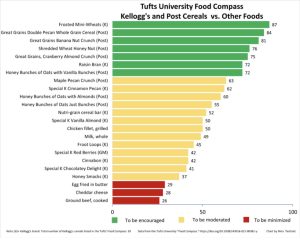
It is official. Up is down and down is up!
Nutrient profiling systems (NPS) aim to discriminate the healthfulness of foods for front-of-package labelling, warning labels, taxation, company ratings and more. Existing NPS often assess relatively few nutrients and ingredients, use inconsistent criteria across food categories and have not incorporated the newest science. Here, we developed and validated an NPS, the Food Compass, to incorporate a broader range of food characteristics, attributes and uniform scoring principles. We scored 54 attributes across 9 health-relevant domains: nutrient ratios, vitamins, minerals, food ingredients, additives, processing, specific lipids, fibre and protein, and phytochemicals. The domain scores were summed into a final Food Compass Score (FCS) ranging from 1 (least healthy) to 100 (most healthy) for all foods and beverages. Content validity was confirmed by assessing nutrients, food ingredients and other characteristics of public health concern; face validity was confirmed by assessing the FCS for 8,032 foods and beverages reported in NHANES/FNDDS 2015–16; and convergent and discriminant validity was confirmed from comparisons with the NOVA food processing classification, the Health Star Rating and the Nutri-Score. The FCS differentiated food categories and food items well, with mean ± s.d. ranging from 17.1 ± 17.2 for savoury snacks and sweet desserts to 81.6 ± 16.0 for legumes, nuts and seeds. In many food categories, the FCS provided important discrimination of specific foods and beverages as compared with NOVA, the Health Star Rating or the Nutri-Score. On the basis of demonstrated content, convergent and discriminant validity, the Food Compass provides an NPS scoring a broader range of attributes and domains than previous systems with uniform and transparent principles. This publicly available tool will help guide consumer choice, research, food policy, industry reformulations and mission-focused investment decisions.
